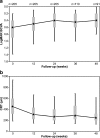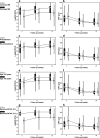Predictive factors for functional improvement after intravitreal bevacizumab therapy for macular edema due to branch retinal vein occlusion
- PMID: 21337042
- PMCID: PMC3042100
- DOI: 10.1007/s00417-010-1470-2
Predictive factors for functional improvement after intravitreal bevacizumab therapy for macular edema due to branch retinal vein occlusion
Abstract
Background: To identify predictive factors for improvement of visual acuity and central retinal thickness by intravitreal bevacizumab for the treatment of macular edema (ME) due to branch retinal vein occlusion (BRVO).
Methods: Two hundred and five eyes from 204 patients with ME secondary to BRVO were retrospectively included at six sites. All eyes received intravitreal bevacizumab therapy (1.25 mg/0.05 ml). The mean follow-up was 36.8 ± 12.7 weeks (range, 18 to 54 weeks). Measurement of ETDRS best-corrected visual acuity (BCVA, in all eyes) and optical coherence tomography (OCT, in 87% of eyes) were performed at baseline and at follow-up examinations every 12 weeks. Using fluorescein angiography, the perfusion status of the macula at baseline could be assessed in 84% of the eyes. The main outcome measures were changes in BCVA and central retinal thickness (CRT). For analysis of predictive factors, the results at 24 weeks were used.
Results: The median BCVA was 0.6 LogMAR at baseline and improved to 0.4 LogMAR at 24 and 48 weeks. This visual improvement was associated by a significant reduction in CRT, decreasing from a baseline of 454 μm to 267 μm and 248 μm after 24 and 48 weeks respectively. Eyes with ME and intact (perfused) or interrupted (ischemic) foveal capillary ring showed a 2-line increase of median BCVA [45 eyes (22%) and 128 eyes (62%) respectively]. However, the final median BCVA was significantly worse in eyes with ischemic ME (0.6 versus 0.3 logMAR in perfused ME). Other factors for visual improvement were absence of previous treatments of the ME, age younger than 60 years and low baseline BCVA (≥0.6 logMAR) (2, 3, and 2 median BCVA lines increase respectively). Furthermore, eyes with duration of the ME of less than 12 months responded with a 3-line increase of the median BCVA. Final CRT only showed minor differences between the subgroups. During the entire follow-up, retreatments were performed in 85% of the eyes, with a median number of injections of three (mean 3.2; range, 1 to 10) and a median time-interval between injections of 11.6 weeks (mean 14.6 weeks).
Conclusions: Intravitreal injection of bevacizumab resulted in a significant improvement of BCVA and reduction of ME in BRVO. Baseline BCVA, patient's age, and duration of BRVO were found to be of prognostic relevance for visual improvement. A less favorable outcome of the bevacizumab therapy in eyes with longstanding BRVO would advocate initiation of treatment within 12 months after onset.
Figures



Similar articles
-
Anti-vascular endothelial growth factor for macular oedema secondary to branch retinal vein occlusion.Cochrane Database Syst Rev. 2020 Jul 7;7(7):CD009510. doi: 10.1002/14651858.CD009510.pub3. Cochrane Database Syst Rev. 2020. PMID: 32633861 Free PMC article.
-
Efficacy of intravitreal bevacizumab for macular edema following branch retinal vein occlusion stratified by baseline visual acuity.Graefes Arch Clin Exp Ophthalmol. 2017 Apr;255(4):691-697. doi: 10.1007/s00417-016-3535-3. Epub 2016 Oct 29. Graefes Arch Clin Exp Ophthalmol. 2017. PMID: 27796671
-
Long-term follow-up of OCT-guided bevacizumab treatment of macular edema due to retinal vein occlusion.Graefes Arch Clin Exp Ophthalmol. 2009 Dec;247(12):1635-41. doi: 10.1007/s00417-009-1151-1. Epub 2009 Jul 26. Graefes Arch Clin Exp Ophthalmol. 2009. PMID: 19633982
-
Spectral-domain optical coherence tomography (SD-OCT) patterns and response to intravitreal bevacizumab therapy in macular edema associated with branch retinal vein occlusion.Graefes Arch Clin Exp Ophthalmol. 2013 Feb;251(2):501-8. doi: 10.1007/s00417-012-2067-8. Epub 2012 Jun 1. Graefes Arch Clin Exp Ophthalmol. 2013. PMID: 22653439
-
Use of bevacizumab for macular edema secondary to branch retinal vein occlusion: a systematic review.Graefes Arch Clin Exp Ophthalmol. 2012 Jun;250(6):787-93. doi: 10.1007/s00417-012-2016-6. Epub 2012 Apr 27. Graefes Arch Clin Exp Ophthalmol. 2012. PMID: 22539192
Cited by
-
Structural and Visual Changes in Branch Retinal Vein Occlusion Patients with Retinal Atrophy.J Ophthalmol. 2022 Aug 18;2022:8945467. doi: 10.1155/2022/8945467. eCollection 2022. J Ophthalmol. 2022. PMID: 36035899 Free PMC article.
-
Anti-vascular endothelial growth factor for macular oedema secondary to branch retinal vein occlusion.Cochrane Database Syst Rev. 2020 Jul 7;7(7):CD009510. doi: 10.1002/14651858.CD009510.pub3. Cochrane Database Syst Rev. 2020. PMID: 32633861 Free PMC article.
-
Microaneurysms cause refractory macular edema in branch retinal vein occlusion.Sci Rep. 2016 Jul 8;6:29445. doi: 10.1038/srep29445. Sci Rep. 2016. PMID: 27389770 Free PMC article.
-
Postconditioning with inhaled carbon monoxide counteracts apoptosis and neuroinflammation in the ischemic rat retina.PLoS One. 2012;7(9):e46479. doi: 10.1371/journal.pone.0046479. Epub 2012 Sep 28. PLoS One. 2012. PMID: 23029526 Free PMC article.
-
Baseline characteristics associated with early visual acuity gains after ranibizumab treatment for retinal vein occlusion.BMC Ophthalmol. 2019 Jan 8;19(1):11. doi: 10.1186/s12886-018-1012-y. BMC Ophthalmol. 2019. PMID: 30621653 Free PMC article. Clinical Trial.
References
-
- The Branch Vein Occlusion Study Group Argon laser photocoagulation for macular edema in branch vein occlusion. Am J Ophthalmol. 1984;98:271–282. - PubMed
-
- The SCORE Study Research Group A randomized trial comparing the efficacy and safety of intravitreal triamcinolone with standard care to treat vision loss associated with macular edema secondary to branch retinal vein occlusion: the standard care vs corticosteroid for retinal vein occlusion (SCORE) study report 6. Arch Ophthalmol. 2009;127:1115–1128. doi: 10.1001/archophthalmol.2009.233. - DOI - PMC - PubMed
Publication types
MeSH terms
Substances
LinkOut - more resources
Full Text Sources
Research Materials

